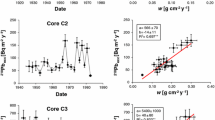Abstract
210Pb has been used for more than two decades to provide the geochronology of annually deposited sediments and to construct pollution histories. Evidence from some lakes suggests that this radionuclide may be adequately mobile to compromise dating reliability. This study provides one test of that possibility by comparing recent measurements of 210Pb and trace metals to ones carried out more than 20 yrs in the past. 137Cs dating is used to confirm sediment accumulation rates in the recent cores. In the three Connecticut, USA, lakes studied, sediment accumulation rates changed abruptly to higher values between 40-50 yrs ago (increasing by factors of 2.2, 2.9, and 3.0). In all three lakes, rates calculated from 210Pb distributions both above and below this horizon agreed, within measurement uncertainty, in recent and older cores. Furthermore, when the older data were corrected for 20 yrs of burial, the changes in slope in 210Pb distributions occurred at the same depth in each pair of cores. The depth of sharp peaks in concentrations of trace metals also matched. In general, this evidence supports the idea that sediments in these lakes have simply been buried, without significant diagenetic remobilization of 210Pb and trace metals . Nevertheless, some important differences were also observed. For two of the three lakes, there was a significant difference in average sediment accumulation rate during the past 33 yrs as calculated from 137Cs and 210Pb in the recent cores. Most potential causes for this difference can be ruled out, and it appears that one of the two nuclides is remobilized compared to the other. There were also significant differences in the total inventories of both 210Pb and trace metals (both up to 2 ×) between recent and older cores in some cases. This may be due to dissimilar sediment focusing, since it is not known for certain whether the new cores were collected at exactly the same sites as in the past.
Similar content being viewed by others
References
Appleby P. G., F. Oldfield, R. Thompson, P. Huttunen & K. Tolonen, 1979. 210Pb dating of annually laminated lake sediments from Finland. Nature 280: 53–55.
Baskaran M. & A. S. Naidu, 1995. 210Pb-derived chronology and the fluxes of 210Pb and 137Cs isotopes into continental shelf sediments, East Chukchi Sea, Alaskan Arctic. Geochim. Cosmochim. Acta 59: 4435–4448.
Benoit G. & H. F. Hemond, 1990. 210Pb and 210Po remobilization from lake sediments in relation to iron and manganese cycling. Environ. Sci. Technol. 24: 1224–1234.
Benoit G. & H. F. Hemond, 1991. Evidence for diffusive redistribution of 210Pb in lake sediments. Geochim. Cosmochim. Acta 55: 1963–1975.
Bertine K. K. & M. F. Mendeck, 1978. Industrialization of New Haven, Conn., as recorded in reservoir sediments. Environ. Sci. Technol. 12: 201–207.
Blais J. M., J. Kalff, R. J. Cornett & R. D. Evans, 1995. Evaluation of 210Pb dating in lake sediments using stable Pb, Ambrosia pollen, and 137Cs. J. Paleolim. 13: 169–178.
Brugam R. B., 1978. Pollen indicators of land-use change in southern Connecticut. Quat. Res. 9: 349–362.
Brush G. S., E. A. Martin, R. S. DeFries & C. A. Rice, 1982. Comparisons of 210Pb and pollen methods for determining rates of estuarine sediment accumulation. Quat. Res. 18: 196–217.
Crusius J. & R. F. Anderson, 1995. Evaluating the mobility of 137Cs, 239+240Pu and 210Pb from their distributions in laminated lake sediments. J. Paleolim. 13: 119–141.
Cutshall N. H., I. L. Larsen & C. R. Olsen, 1983. Direct analysis of lead-210 in sediment samples: self absorbtion corrections. Nucl. Instr. Meth. 206: 309–312.
Dillon P. J., P. J. Scholer & H. E. Evans, 1986. 210Pb fluxes in acidified lakes. In Sly, P. G. (ed.), Sediments and Water Interactions. Springer-Verlag, New York, 491–499.
Erten H. N., H. R. von Gunten, E. Rossler & M. Sturm, 1985. Dating of sediments from Lake Zurich (Switzerland) with 210Pb and 137Cs. Swiss J. Hydrol. 47: 5–11.
Hutchinson G. E., 1975. In A Treatise on Limnology. John Wiley & Sons, New York.
Krishnaswami S., D. Lal, J. M. Martin & M. Meybeck, 1971. Geochronology of lake sediments. Earth Planet. Sci. Lett. 11: 407–414.
Pennington W., R. S. Cambray & E. M. Fisher, 1973. Observations on lake sediments using fallout 137Cs as a tracer. Nature 242: 324–326.
Robbins J. A. & D. N. Edgington, 1975. Determination of recent sedimentation rates in Lake Michigan using Pb-210 and Cs-137. Geochim. Cosmochim. Acta 39: 285–304.
Rowan D. J., J. Kalff & J. B. Rasmussen, 1992. Estimating the mud deposition boundary depth in lakes from wave theory. Can. J. Fish. Aquat. Sci. 49: 2490–2497.
Taylor J. R., 1982. In An Introduction to Error Analysis. University Science Books, Sausalito, CA, 270 pp.
Wan G. J., P. H. Santschi, M. Sturm, K. Farrenkothern, A. Lueck & E. Werth, 1987. Natural (210Pb, 7Be) and fallout (137Cs, 239,240Pu, 90Sr) radionuclides as geochemical tracers of sedimentation in Greifensee, Switzerland. Chem. Geol. 63: 181–196.
Author information
Authors and Affiliations
Rights and permissions
About this article
Cite this article
Benoit, G., Rozan, T.F. 210Pb and 137Cs dating methods in lakes: A retrospective study. Journal of Paleolimnology 25, 455–465 (2001). https://doi.org/10.1023/A:1011179318352
Issue Date:
DOI: https://doi.org/10.1023/A:1011179318352




